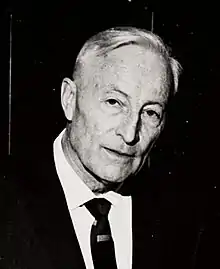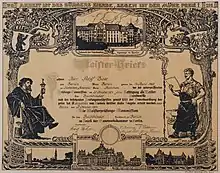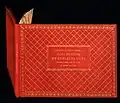George A. Baer
George A. Baer (April 14, 1903 – July 24, 1994) was a German/Swiss/American bookbinder. He specialized in fine leather bindings, including inlays and gold tooling.
George A. Baer | |
|---|---|
 George Baer, 1960s. | |
| Born | George Adolf Baer 14 April 1903 |
| Died | 24 July 1994 (aged 91) |
| Nationality | USA |
| Occupation | Master Bookbinder |
| Employer | Cuneo Press, Chicago |
| Spouse(s) | Maly Baer
(m. 1933; div. 1959) |
| Children | Peter Baer, Tomas Baer, Christian Baer |
Much of Baer's work involved the restoration of old and rare books for both private customers and numerous rare book libraries around the world. His well-established reputation in this field led to an invitation to help restore books in the Florence, Italy libraries that were water-damaged in the devastating 1966 Flood of the Arno River.[1] Mostly working from his private studios, books bound by him were sold to patrons including Queen Juliana of the Netherlands, the President of France, and Pope Pius XII.
Early life and training
George Adolf Baer was born in Hoboken NJ of German parents, who had immigrated to the US in September, 1902,[2] but returned to Germany shortly after George’s birth. George grew up in Wiesbaden, a German city along the Main River, near Frankfurt. He served a three-year apprenticeship at a book binding company in Wiesbaden from 1919 to 1922. As he recounted in a taped interview,” this was not a fine binding establishment”.[3] It involved strictly binding books with cloth covers. After a year working in a paper making factory and teaching bookbinding at an art school, he decided to pursue fine bookbinding. He was accepted at the Berlin School of Applied Arts under the tutelage of Paul Kersten, one of the foremost bookbinders in Germany.[4] On October 25, 1924, at the age of 21, he received his "Meister Brief für das Buchbinder Handwerk"

Teaching career
In addition to learning the art of leather binding and gold tooling, Kersten engaged Baer to assist in teaching at the Applied Arts school. In October of 1925 Baer was offered his first independent position at the Staatliche Kunstgewerbeschule in Kassel to teach bookbinding.[2] In March of 1927, Baer had an offer to set up a bookbinding school and to teach bookbinding in Lixouri on the Ionian island of Cephalonia in Greece. He spent 3 ½ years there before returning to Germany in 1931.[2]
Life in Switzerland
However, by 1931 the Nazi movement in Germany made it difficult for Baer, whose father was Jewish, to find employment. So, he decided to move to Zürich, Switzerland. Within a few years he set up his own shop and married Martha Lena (Maly) Guyer, a Swiss artist at that time specializing in fabric design, primarily curtains for upscale restaurants.[5][6] During the next 15 years a number of George Baer’s book covers were designed or greatly influenced by Maly.
In 1941 the Baers with their sons bought a farmhouse in Bassersdorf, a small village just outside of Zürich, where they practiced their respective crafts, tended a large garden, and managed a small menagerie of sheep, chickens, and eventually even a cow.[7] After the war several weekly magazines featured this bookbinder/artist/farming family that by all appearances seemed to have found “the happy life”.[8][7] Among the problems not mentioned in these articles was the fact that Maly, whose Swiss roots go back to Jakob Gujer (also written as Guyer) in the early 1700’s, lost her Swiss citizenship because she married a foreigner, and their three Swiss born children also were stateless.[2] As a result, early in the war, the US-born George Baer contacted the US consulate in Zürich to establish his right to US citizenship.[3] In 1949, being unable to resolve the citizenship issue with the Swiss authorities, George Baer decided to move to the US where the rest of the family joined him in 1951.[3]
Career in the United States
Through Baer’s earlier work in restoring ancient Aramaic letters for Ludwig Borchardt, an Egyptologist in Cairo, he made contact with Prof. Keith Seele[9] at the Chicago Oriental Institute who helped him find a position in the fine binding department of the Cuneo Press. Fine binding was a flourishing art at the time in Chicago with such binders as Leonard Mounteney, Alfred de Sauty, Harold Trobolet, Elisabeth Knerr, George Baer[10] and later William Anthony all active. Among these George Baer was particularly noted for his “bold and imaginative covers, with sensitive use of color”.[10] Baer worked at the Cuneo Press fine binding department from 1950 to 1971, as well as in his own workshop binding books for private clients and restoring books for libraries, especially the University of Minnesota Rare Book room.
In 1972 George Baer moved to Chapel Hill, North Carolina,[11] where he continued working from his home, binding and/or restoring books for the University of North Carolina Rare Book room as well as for private clients in the region. In addition, he taught bookbinding for several years through the UNC evening college. When George Baer finally retired a second time at the age of 81, he donated his collection of fine bindings and other documents to the University of North Carolina at Chapel Hill Library. The books are now housed in the Rare Book Room as part of the George Baer Collection of Bookbinding (see link in the External Link Section).
George Baer as an Artist
When Baer first studied fine bookbinding in the early 1920s with Paul Kersten in Berlin, the decorative designs on books were traditional and often very ornate. But, just at this time German art and applied art were being transformed by the Bauhaus movement initiated by the architect, Walter Gropius. This group of artists stressed the merger of function and art as well as simplicity of design. It became Baer’s guiding principle in binding and decorating books. As he pointed out in a taped interview in 1986, Baer said that a book, first of all, has to be well constructed and should be bound so that it can be read – “a well-bound book should last 100 to 200 years”.[3] For this reason Baer did not like the “French method of book binding because they shaved the leather too thin” to make them elegant but at the expense of a considerably shorter life span for the binding. In addition, Baer adopted simple and clean modern designs that were inspired by the book’s content.[3] “When I was a student I was told a bookbinder should never read books, otherwise he would not make a living.“[3] But early on he began his work “by reading the book and getting a feeling for the design, type and colors” and then he reflected, “sometimes for months”, until he got the idea for the book cover design.[12]
Exhibitions
- Exposition Internationale des Arts et des Techniques, Paris (1937)
- Swiss Landesaustellung, Zurich (1939)
- Traveling Exhibitions in Germany and Sweden (1959)
- Chicago Public Library (1961)
- Kalamazoo Institute of Arts (1962)
- John Crerar Library, then at the Illinois Institute of Technology, Chicago (1965)
- Milwaukee Public Library (1967)
Selected Books Bound by George Baer
References
- "Americans Who Helped in the Florence Flood Rescue Effort". Abbey Newsletter (Vol. 20 No. 8). December 1996. Retrieved 5 January 2018.
- Baer, George, Personal papers of George Baer, Rare Book Room of the University of North Carolina Library
- Baer, George (1986). "My Life as a Bookbinder" (Interview). Interviewed by Mary Morrow. Chapel Hill, NC.
- "Teaching Genealogies of American Hand Bookbinders". Guild of Book Workers journal (Vol. 28 No. 1, 2). 1990.
- "Eine Frau arbeitet für die Wohnkultur". Concett&Huber's Wochen-Blätter. Zürich: Concett&Huber Verlag. April 26, 1941.
- "Maly Baer entwirft künstlerische Stoffe und Vorhänge". Annbelle. Zürich: Buchdruckerei a/d Sihl, Zurich. September 1, 1942.
- "USA Bürger Buchbinder und Bauer (US citizen, bookbinder, and Farmer)". Heim und Leben. Luzern: C.J. Bucher AG. July 24, 1948.
- "La Maison Suisse est celle de La Vie Heureuse". La Vie Heureuse. Paris: La Vie Hereuse:Hebdomadaire de la Femme. April 23, 1947.
- "Keith C. Seele February 13, 1898-July 23,1971". Journal of Near Eastern Studies. No. Vol. 32 No. 1, 2. Chicago: University of Chicago Press. 1973.
- Thompson, Lawrence S. (1962). "Bookbinding in the Americas". Revista Interamericana de Bibliografía. 12 (3): 253–268.
- "Bookbinding/". The Daily Tar Heel. August 2, 1979. Retrieved 5 January 2018.
- Seitz, Johanna (December 21, 1975). "Master Bookbinder at Work: Every book needs special care". The Chapel Hill Newspaper. Chapel Hill, NC.


